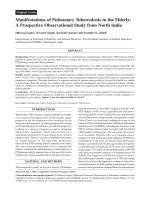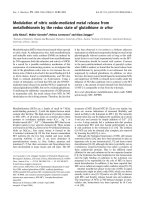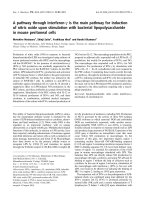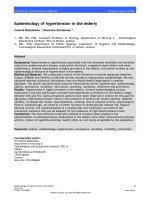Inhaled nitric oxide for treatment persistent pulmonary hypertension in the newborn
Bạn đang xem bản rút gọn của tài liệu. Xem và tải ngay bản đầy đủ của tài liệu tại đây (2.04 MB, 23 trang )
Dr NGUYEN NGUYEN HUY
ICU
PERSISTENT PULMORNARY
HYPERTENSION OF THE NEWBORN
(PPHN)
PPHN : pulmonary vascular resistance (PVR) remains
elevated after birth, resulting in right-to-left shunting
of blood through fetal circulatory pathways
Three types of abnormalities of the pulmonary
vasculature : underdevelopment, maldevelopment,
and maladaptation
1.9/ 1000 live births
NITRIC OXIDE
Does Inhaled NO effect in
PPHN ?
Nitric oxide for respiratory failure in infants
born at or near term : Systematic Review
And Meta-Analysis
Methods :
14 RCTs
735 term and near-term infants (> 34 weeks gestation)
Newborn infants :hypoxemia cause by lung disease,
pulmonary hypertension with right to left shunting, or
both
Exclude : intracardiac shunting due to structural
congenital heart disease
iNO / PPHN
outcome
iNO (N)
Control(N)
mean
difference
1. Death or
requirement of
ECMO
418
335
2. Change
Oxygenation
index after
treatment
114
119
-15.1[-20.52;9,68]
3. Change PaO2 114
after
treatment
119
50.4 [32.14;
68,66] mmHg
RR , 95% CI
0.65 ( 0,550,76)
iNO/PPHN
Outcome
iNO (N)
4.Neurodevelopme 120
ntal disability
Control (N)
RR , 95% CI
181
0.97(0.66;1.84)
5.Hearing
impairment in at
least one ear
among survivors
75
82
1.14(0.71;1.84)
6.Cerebral palsy
among survivors
120
179
1.02( 0.49; 2.14)
iNO / Congenital diaphragmatic
hernia
Outcome
iNO (N)
Control (N)
Mean
Difference
1. Death or
requirement
of ECMO
38
46
2. Change
Oxygenation
index after
treatment
21
23
-6.7[ 18.39;4.99]
3. Change
PaO2 after
treatment
21
23
6.7[ -2.32;
15.72] mmHg
RR , 95% CI
1.09(0.95; 1.26)
C O N C L U S I O N S (1)
Near-term and terminfants with hypoxic respiratory
failure unresponsive to other therapy, excluding
infants with diaphragmatic hernia, should have a trial
of inhaled nitric oxide.
Low dose or high dose iNO ?
5 ppm or 20 ppm or 80 ppm
Efficacy results were similar among NO
doses
Davidson D, Barefield ES, Kattwinkel J, Dudell G, Damask M, Straube R, Rhines J,
Chang CT . Inhaled nitric oxide for the early treatment of persistent
pulmonary hypertension of the term newborn: a randomized, doublemasked, placebo-controlled, dose-response, multicenter study. The INO/PPHN Study Group. Pediatrics. 1998;101(3 Pt 1):325
Low-dose nitric oxide therapy for persistent
pulmonary hypertension of the newborn.
Clinical Inhaled Nitric Oxide Research Group.
N Engl J Med. 2000;342(7):469
Methods
248 neonates who were born after 34 weeks' gestation
PPHN with OI ≥ 25
Low dose iNO : 20 ppm for a maximum of 24 hours,
followed by 5 ppm for no more than 96 hours
Control : not using iNO
outcome
iNO
Control
P
Need ECMO
48/126(38%)
78/122(64%)
0.001
Mortality after 30
days
similar
Chronic lung
disease developed
7%
20%
0.02
CONCLUSIONS (2) :iNO reduces the extent to
which ECMO is needed in neonates with
hypoxemic respiratory failure and pulmonary
hypertension
Methaemoglobinaemia risk factors with inhaled
nitric oxide therapy in newborn infants
Acta Paediatr. 2010;99(10):1467
Methods :
Neonates who were treated with iNO and had at
least one MetHb measurement were included.
Demographic characteristics and methods of iNO
administration (dosage, duration) at the time of each
MetHb measurement were analysed
RESULT
• 442 MetHb measurements from 81 premature and 82 term
and near-term infants
• Higher maximum dose of iNO (22.7 vs 17.7 p.p.m ) was a
significant risk factor for elevated MetHb
• Higher oxygen levels (FiO2 = 75.5% vs 51.7%) were
associated with higher MetHb in term infants
• Preterm infants had no risk for high MetHb when iNO was
kept below 8 p.p.m
CONCLUSION (3) : High MetHb is exceptional in neonates
treated with low dose iNO. Associated risk factors are
related to high iNO dose and the simultaneous use of
high concentrations of oxygen
Early versus standard iNO ?
A randomized trial of early versus standard inhaled
nitric oxide therapy in term and near-term newborn
infants with hypoxic respiratory failure
Pediatrics. 2004;113(3 Pt 1):559
Methods :
>or =34 weeks' gestation
Early iNO : OI 15 -25 on any 2 measurements in a 12hour interval ( 150 patients)
Control (standard therapy ) :OI ≥ 25 were given iNO as (
149 paitients)
RESULT
CONCLUSION (4) :iNO improves oxygenation but does not
reducethe incidence of ECMO/mortality when initiated at an
OI of 15 to 25 compared with initiation at>25 in term and
near-term neonates with respiratory failure
Randomized controlled trial of early compared with
delayed use of inhaled nitric oxide in newborns with a
moderate respiratory failure and pulmonary
hypertension
J Perinatol. 2010 Jun;30(6):420-4. Epub 2009 Nov 5
Methods :
56 patients
early iNO with 20 ppm ( OI 10 – 30, 48h after birth)
control ( CMV with FiO2 = 100%)
RESULT
CONCLUSION (5) :Early use of iNO in newborns
with moderate respiratory failure improves
oxygenation and decreases the probability of
developing severe hypoxemic respiratory failure
CONCLUSION
iNO effect in PPHN
Efficacy results were similar among NO doses
High dose iNO , high concentrations of oxygen : high
risk MetHb
Early use of iNO : improves oxygenation and decreases
the probability of developing severe hypoxemic
respiratory failure









